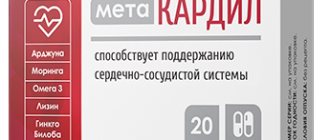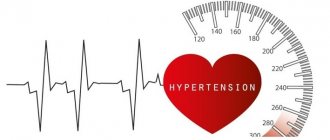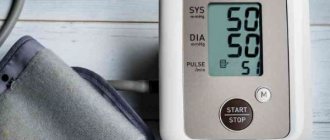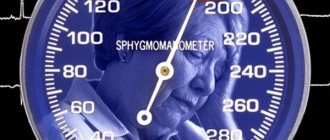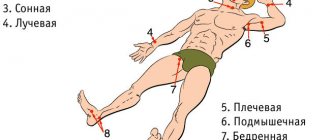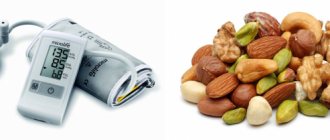The first drug with 2000% bioavailability
As long as you wait, your chances of getting rid of hypertension are decreasing!
To learn more…
When pressure rises, many negative consequences appear. The internal target organs suffer the most, namely the heart, kidneys, blood vessels, and brain. A pressure of 190 over 110 is considered critical and can cause death due to stroke or other complications. Such values indicate stage 3 hypertension. The disease refers to a severe form of progression, when it is no longer possible to achieve normal indicators, and the relative stability of the condition can only be maintained with medications. With such pressure, irreversible processes occur in patients.
What does 190/110 mmHg mean? Art.
A disease such as stage 3 hypertension is a dangerous form of pathology in which a pressure of 190/110 mm Hg appears. Art. Certain organs in the human body are already affected and cannot be cured. It is no longer possible to reduce the pressure to normal limits. If there is a sharp decline in indicators, then this indicates a heart failure, in which case you need to consult a doctor or call an ambulance.
With grade 3 hypertension, frequent hypertensive crises occur, often with fatal outcomes. As statistical data show, pathology is typical for:
- 40% men and 42% women under 50 years of age.
- 25% of men under 40 years of age, as a result of alcohol abuse.
The pathology appears after 60 years, but the risk increases as a result of aging, as well as concomitant diseases such as diabetes. For young people, stage 3 hypertension with readings of 190 over 110 is uncharacteristic. Such a disease can only occur after serious head injuries.
Stages and degrees of risk
It is important to know!
STILL STRUGGLE WITH ARTERIAL HYPERTENSION INCORRECTLY? The first bioavailable drug with proven effectiveness Read more »
In medical practice, there are several stages of stage 3 hypertension:
- When there are no changes in internal organs.
- Several organs are affected.
- Many organs are affected, and complications such as heart attack and other things are observed.
With a pressure of 190 to 110, people experience certain risks, in the form of complications that appear from the blood vessels and heart. For hypertension, there are 4 forms of risk that appear over 10 years:
- The risk of complications is up to 15%.
- The appearance of pathologies in 15-20% of cases.
- Complications up to 30% of cases.
- Development of pathologies in more than 30% of cases.
People with blood pressure 190/110 mm Hg. Art. belong to risk group 3-4, because this condition indicates that some organs are already affected.
Prevention measures and prognosis
With a high blood pressure of 190 to 110, the prognosis is unfavorable. Such high rates lead to disruption of the functioning of the main internal organs and vital systems. If stage 3 or 4 hypertension is diagnosed, the likelihood of developing a heart attack or stroke due to high blood pressure remains high. The patient is sent to the hospital to monitor the condition so that the hypertensive crisis can be stopped in a timely manner.
To reduce the likelihood of severe consequences of a hypertensive crisis, it is necessary to monitor your health and take preventive measures:
- minimal physical activity;
- proper nutrition;
- weight control;
- quitting smoking and alcohol.
Doctors recommend establishing a proper sleep schedule, which should be at least 8 hours. If you suspect hypertension, you must regularly measure your blood pressure twice a day: morning and evening, and record them in a special diary. You should definitely visit your doctor twice a year.
Causes of pressure 190 to 110
The main reason for pressure 190 to 110 and the transition of the condition to stage 3 is characterized by insufficient, ineffective treatment of hypertension at earlier stages. This condition appears as a result of the patient himself, who did not adhere to the rules of treatment, or an incompetent doctor, who prescribed the wrong drugs.
In addition, the development of severe hypertension is influenced by other reasons, which include:
- Stress.
- Additional diseases, the course of which worsened with increasing pressure.
- Diabetes.
- Atherosclerosis.
Today, hypertension cannot be completely cured, but its development can be stopped and the appearance of certain symptoms and hypertensive crises can be eliminated.
Danger signs
When dangerous complications develop, specific manifestations develop:
- Intense, pressing pain behind the sternum (possible heart attack).
- Difficulty speaking, gait, inability to control facial muscles (stroke).
- Pain in the back (problems with the aorta).
- Choking (heart failure, swelling of the pulmonary structures).
The duration of a hypertensive crisis is from several hours to 2-3 days. The longer the condition lasts, the higher the likelihood of fatal or disabling complications.
Symptoms
Hypertension of this form and course is characterized by the same symptoms as a milder course of the disease. But in this case, damage to various target organs is added:
- Vessels. As pressure increases, the walls of blood vessels thicken, they narrow, and plaques form. This leads to circulatory failure.
- Organs of vision. The pathology causes visual impairment, complete blindness and retinal detachment are possible.
- Kidneys. Due to impaired blood flow, the kidneys are affected, their structure changes, and normal functioning is disrupted. Patients develop kidney failure and other problems. The blood is not able to filter normally, fluid is retained in the body, manifesting itself in the form of swelling of the limbs and other parts of the body.
- Heart. The ability to function normally is lost, and organ failure develops.
- Brain. Encephalopathy develops, the patient’s mental abilities decrease, and memory deteriorates. Blood clots form in the brain, leading to stroke.
Lesions of the described organs provoke the following symptoms:
- The patient's coordination is impaired and his gait changes.
- Speech deteriorates and becomes slurred.
- Vision decreases, dark spots appear before the eyes, and sharpness is lost.
- The skin becomes red, especially on the face and neck.
- The limbs often go numb and their sensitivity disappears.
- Sweating increases.
- Headaches, dizziness, heart pain.
- Fainting state.
- Shortness of breath at rest.
- Noise and ringing in the ears.
In particularly difficult situations, patients cannot take care of themselves and require third-party care. If any of the described symptoms appear, you should immediately call an ambulance.
Why is increased lower blood pressure dangerous?
With a constant increase in diastolic pressure to 85–90 mmHg, the vessels experience enormous stress. They lose their usual tone, become fragile and inelastic. As a result, a person develops new pathologies and worsens existing ones.
If you ignore the symptoms of isolated diastolic hypertension, when the lower value is constantly growing, the risk of atherosclerotic plaques forming in the vessels and completely blocking their lumen increases. Plaques form only in arterial capillaries; venous ones are not affected by this pathology, since they do not consist of muscle tissue and do not experience excessive stress.
If earlier diastolic pressure was not given due attention, believing that only the upper reading of the tonometer was important, now doctors have come to the conclusion that both numbers are important. Increased diastole has three stages:
- first - the lower indicator rises to 90–100 mmHg;
- second – diastolic numbers reach 101–110 units;
- third – the lower threshold exceeds 110 mmHg.
This condition is constantly getting worse, which is why the risk of developing atherosclerosis increases, the condition of the capillaries worsens, and the body experiences a lack of oxygen. Dangerous consequences of untreated isolated diastolic hypertension are hemorrhage in the brain and retina, loss of visual function, and myocardial infarction.
Complications
At a pressure of 190 to 110, a person’s body is completely destroyed. Depending on the severity of the condition, the consequences may vary. When blood circulation in the brain is interrupted, strokes occur; in this case, a person does not feel his fingers and toes, and in some cases, sensitivity disappears in the entire arm or leg. Loss of consciousness occurs.
Pressure greatly affects the functioning of the heart; as a result of high levels, the rhythm becomes disrupted, the pulse quickens, angina pectoris develops, and a heart attack develops. The main complications of stage 3 hypertension include:
- Heart attack.
- Stroke.
- Suffocation.
- Pulmonary edema.
- Blindness.
- Nephropathy.
- Kidney failure.
With grade 3 hypertension, blood pressure 190 over 110 and the patient’s serious condition, he is assigned group 1 disability. In this state, a person cannot work normally, and sometimes is not able to take care of himself. Sometimes patients are allowed to work, but there are a number of restrictions, as well as requirements for working conditions. To reduce mortality, regular rehabilitation is carried out in case of disability.
Forecast
Directly depends on the speed of initiation of treatment, the conditions of therapy, the age of the patient, the general health of the patient (the younger and stronger the person, the higher the likelihood of a favorable outcome).
You also need to decide what you mean by forecast:
- Prognosis for life: conditionally favorable with early initiation of therapeutic measures. If complications develop, it worsens.
- The prognosis for maintaining working capacity is also conditionally favorable. Invalidation is possible as a result of the development of complications.
Quality of life also depends on the speed of initiation of treatment. The longer a person remains in this state, the more likely it is to die or have dangerous consequences.
What to do if the pressure is 190 to 110
In the event of a sharp rise in pressure or rapid deterioration of the condition, you will need to immediately call an ambulance. Before the doctor arrives, it is necessary to provide maximum assistance to the person, try to reduce blood pressure, and get rid of negative symptoms and complications. To do this you need:
- Everyone should calm down, especially the patient, you can use sedatives.
- Open the windows in the room, let in fresh air, which will improve breathing.
- Lay the person down and place several pillows under the head so that it is on an elevated position.
- If pain in the heart appears, put Nitroglycerin under the tongue and dissolve it; in case of strong excitement, give 30-40 drops of Corvalol.
- If there has already been a crisis before, then you need to use antihypertensive pills prescribed by the doctor.
- If it is impossible to use medications, you should place a towel soaked in a vinegar solution on your feet or immerse the patient’s arms and legs in warm water for 15 minutes.
The described measures will slightly improve the condition. Upon the arrival of the doctors, it is necessary to say what measures were used to relieve the symptoms.
Drug treatment
Therapy for hypertension is very long, and if the pressure is 190 to 110, then you will need to use pills for the rest of your life. All medications are prescribed only by a doctor, after diagnosis and testing. When prescribing treatment, doctors take into account not only examination data, but also the patient’s complaints. For grade 3 hypertension you can use:
- Diuretics. They are well tolerated by patients and are highly effective in treatment. The tablets affect the cardiovascular system and improve kidney function. Prescribed Indap, Arifon.
- Beta blockers. Tablets are recommended if the patient has angina, heart disease, or has previously had a heart attack. Bisoprolol, Metopropol are recommended. The drug quickly stops high tonometer readings and improves heart function.
- ACE inhibitors. Prescribed to patients who have periodic severe attacks. The tablets are well tolerated by anyone; the most commonly used are Captopril and Enalapril.
Some people take Papazol for high blood pressure; they can use the drug themselves without a doctor’s prescription. Indeed, the medicine is effective and does not have negative consequences, only if it is taken correctly in the right dose.
The described drug treatment has positive results. But only doctors should prescribe them, in a certain dosage.
Folk remedies
IT IS IMPORTANT TO KNOW!
STILL STRUGGLE WITH ARTERIAL HYPERTENSION INCORRECTLY? Reduces stress hormone levels and prevents oxygen starvation Read more »
Patients who are not stable hypertensive patients whose blood pressure rises quite rarely, then at 190 to 110 there is no need to rush to take medications. In this case, treatment can be carried out with folk remedies, but this is also discussed with the doctor. Treatment is carried out using the following methods:
- Beetroot juice. This product should be on the menu of any patient with hypertension. Beetroot juice is great for reducing blood pressure. It is consumed only fresh, approximately 150 ml three times a day before meals. A period of 3 weeks or more is suitable as a course of treatment.
- Lemon, beets, honey. This mixture recipe helps reduce blood pressure as quickly as possible. Beet juice, add a little lemon juice and add 1-2 tsp. honey You need to drink 2 tbsp. an hour after eating.
- Valerian with motherwort. It is recommended to use pressure during stress as a result of growth. The ingredients are mixed in equal parts, per 1 tbsp. add 250 ml of boiling water and leave for 30 minutes. After straining, take ½ glass three times a day.
- Garlic juice. Excellent for hypertensive patients, it quickly and gently cleanses blood vessels. 20 drops of juice are diluted in 250 ml of milk and taken 2 times a day.
- Viburnum juice. You need to consume 50 ml three times a day. It is also useful to simply eat berries sprinkled with sugar.
- Green tea. The drink helps with hypertension and prevents the appearance of atherosclerotic disease.
The described traditional medicine must be supplemented with gymnastics or other types of exercise, which are recommended by the doctor individually for each patient. Perhaps it will be a regular walk before bed.
